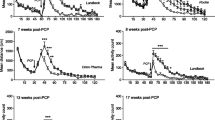Abstract
The low rate of success for identifying effective treatments for cognitive dysfunction has prompted recent efforts to improve pharmaceutical discovery and development. In particular, investigators have emphasized improving translation from pre-clinical to clinical research. A specific area of focus has been touchscreen technology; this computer-automated behavioral testing method provides an objective assessment of performance that can be used across species. As part of a larger multi-site study with partners from the Innovative Medicines Initiative (IMI), two US sites, AbbVie and Pfizer, conducted a cross-site experiment with a common protocol for the visual discrimination (VD) task using identical testing equipment, stimuli, and rats of the same strains, sex, and age from the same supplier. As most touchscreen-based rodent experiments have used Lister–Hooded rats that are not readily available outside of Europe, a strain comparison with male Long–Evans rats was conducted as part of the study. Rats were trained for asymptotic performance, and test sessions were performed once per week in a full crossover design with cognition-impairing drugs. Drugs tested were phencyclidine and S-ketamine (N-methyl-d-aspartate (NMDA) antagonists), d-amphetamine (indirect dopamine agonist), and scopolamine (muscarinic antagonist). Satellite brain and plasma samples were taken to confirm appropriate exposures. Results indicate that both rat strains show similar patterns of impairment, although Lister–Hooded rats were more sensitive than Long–Evans rats to three out of four drugs tested. This suggests that researchers should fully explore dose–response relationships in their strain of choice and use care in the interpretation of reversal of cognitive impairment.




Similar content being viewed by others
References
Auclair AL, Besnard J, Newman-Tancredi A, Depoortère R (2009) The five choice serial reaction time task: comparison between Sprague–Dawley and Long–Evans rats on acquisition of task, and sensitivity to phencyclidine. Pharmacol Biochem Behav 92(2):363–369
Bussey TJ, Padain TL, Skillings EA, Winters BD, Morton AJ, Saksida LM (2008) The touchscreen cognitive testing method for rodents: how to get the best out of your rat. Learn Mem 15:516–23
Kaitlin KI (2010) Deconstructing the drug development process: the new face of innovation. Clin Pharmacol Ther 87:356–361
Kozak R, Mulryan L, Eastwood BJ, Chapin DS, Ballard T, Gilmour G, Gastambide F, Dix S, Janhunen SK, Plath N, Talpos J, Fellini L, Lerdrup L, Billa S, Ahokas I, Saksida LM, Mohler EG, Rueter LE, Malik N, Wyler R, Bussey T, Steckler T, Tricklebank M, Robbins, TW (2012) Multi-site validation of touch screen-based translational assays of cognition and their pharmacological sensitivity. Poster presented at the ACNP 51st Annual Meeting in Hollywood, FL
Kumar G, Talpos J, Steckler T (2015) Strain-dependent effects on acquisition and reversal of visual and spatial tasks in a rat touchscreen batter of cognition. Physiol Behav 133:26–36
Lenz RA, Baker JD, Lock C, Rueter LE, Mohler EG, Wesnes K, Abi-Saab W, Saltarelli MD (2012) The scopolamine model as a pharmacodynamic marker in early drug development. Psychopharmacology 220:97–107
Serroyen J, Molenberghs G, Verbeke G, Davidian M (2009) Non-linear models for longitudinal data. Am Stat 63(4):378–388. doi:10.1198/tast.2009.07256
Smith JW, Gastambide F, Gilmour G, Dix S, Foss J, Lloyd K, Malik N, Tricklebank M (2011) A comparison of the effects of ketamine and phencyclidine with other antagonists of the NMDA receptor in rodent assays of attention and working memory. Psychopharmacology (Berl) 217(2):255–69
Takeuchi H, Suzuki T, Remington G et al (2013) Effects of risperidone and olanzapine dose reduction on cognitive function in stable patients with schizophrenia: an open-label, randomized, controlled, pilot study. Schizophr Bull 39:993–998
Talpos JC, Fletcher AC, Circelli C, Tricklebank MD, Dix SL (2012) The pharmacological sensitivity of a touchscreen-based visual discrimination task in the rat using simple and perceptually challenging stimuli. Psychopharmacology 221:437–49
van Goethema NP, Ruttena K, van der Staay FJ, Jans LAW, Akkermana S, Steinbuscha HWM, Blokland A, van’t Kloosterc J, Prickaerts J (2012) Object recognition testing: rodent species, strains, housing conditions, and estrous cycle. Beh Br Res 232:323–34
Acknowledgments
This work was funded by AbbVie and Pfizer and received support from the NEWMEDS Innovative Medicine Initiative Joint Undertaking (grant 115008), composed of EFPIA in-kind contribution and financial contribution from the EU’s 7th Framework Program (FP7/2007-2013). AbbVie and Pfizer were responsible for the study design, research, analysis, data collection, interpretation of data, and writing, reviewing, and approving of the publication. Eric G. Mohler and Lynne E. Rueter are currently employed by AbbVie and may own AbbVie stock. Douglas Chapin, Damon Young, and Rouba Kozak are current or previous employees of Pfizer and may own Pfizer stock.Portions of this work (Lister–Hooded behavioral data and plasma exposures) are included as part of a larger multi-site comparison study. This strain comparison serves as a companion piece.
Author information
Authors and Affiliations
Corresponding author
Electronic supplementary material
Below is the link to the electronic supplementary material.
ESM 1
(DOC 2394 kb)
Rights and permissions
About this article
Cite this article
Mohler, E.G., Ding, Z., Rueter, L.E. et al. Cross-site strain comparison of pharmacological deficits in the touchscreen visual discrimination test. Psychopharmacology 232, 4033–4041 (2015). https://doi.org/10.1007/s00213-015-4012-0
Received:
Accepted:
Published:
Issue Date:
DOI: https://doi.org/10.1007/s00213-015-4012-0




